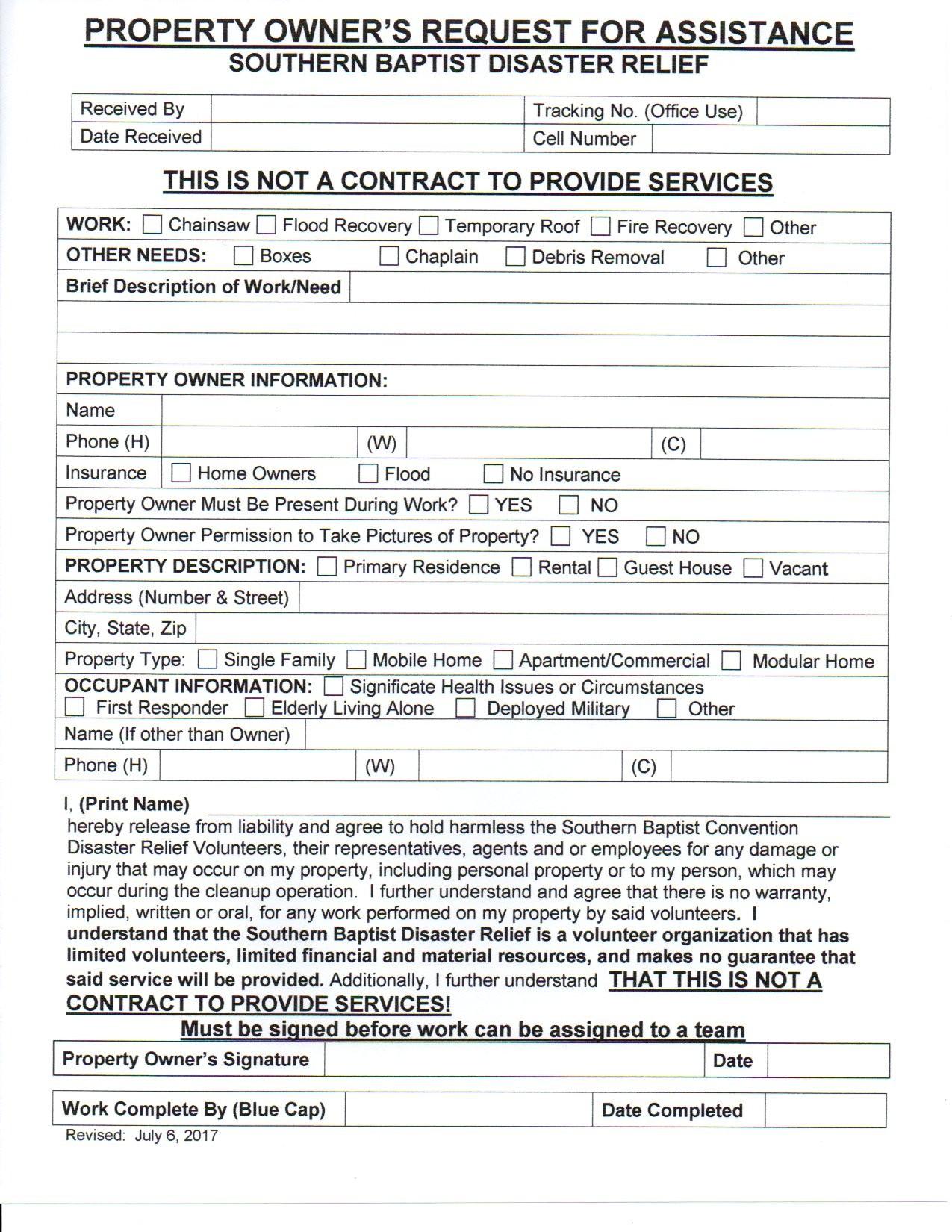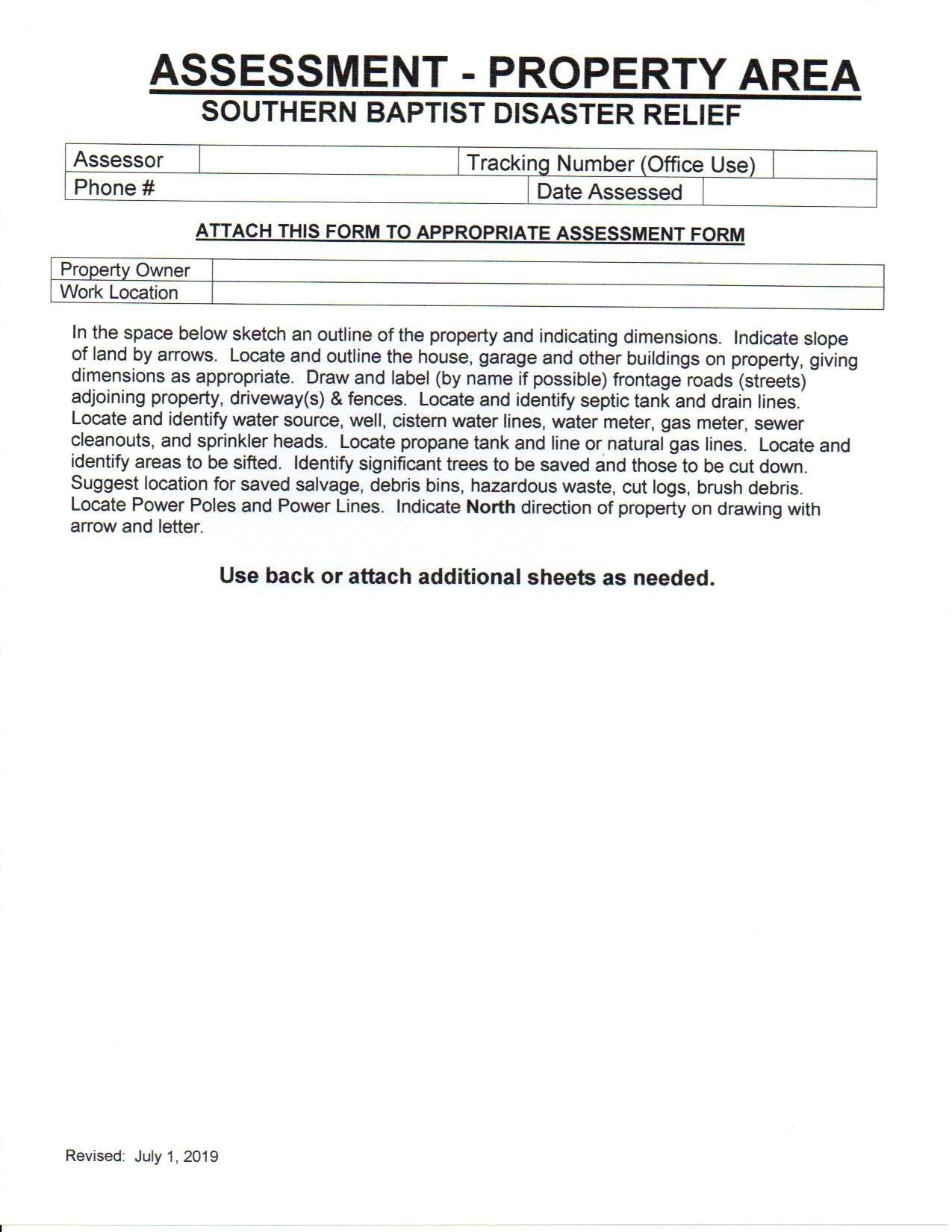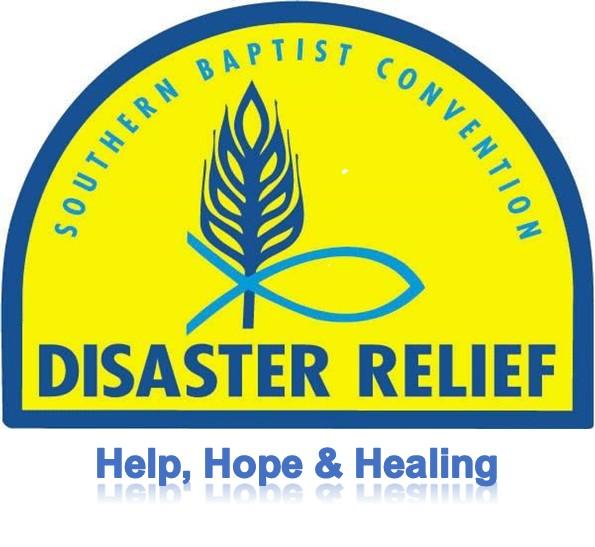

SBDR FIRE RECOVERY MANUAL
Revised: Revision 11/01/19
Mission Statement:
Southern Baptist Disaster Relief is a Christcentered partnership of national, state and associational ministries serving through the local church to bring help, healing and hope to individuals affected by disasters.


Vision Statement:
Southern Baptist Disaster Relief will be a welldefined, unified disaster response organization, demonstrating the love of Christ by providing physical and spiritual help to those affected by disasters.

SBDR FIRE RECOVERY MANUAL
Introduction
Southern Baptist Disaster Relief (SBDR) is a Christ-centered partnership of national, state and associational ministries serving through the local church to bring help, healing and hope to individuals affected by disasters.
SBDR began in Texas in 1967 and has grown to be one of the largest and most respected disaster organizations in the U.S. and around the world.
Fire Recovery is a vital component of the Disaster Relief Recovery Ministry.
Bible Verses
Unless otherwise noted, all scriptures are taken from the Christian Standard Bible copyright 2017 by Holman Publishers (HCSB). Used by permission.
Galatians 6:9-10
9 So we must not get tired of doing good, for we will reap at the proper time if we don’t give up. 10 Therefore, as we have opportunity, we must work for the good of all, especially for those who belong to the household of faith.
Philippians 2:13
13 For it is God who is working in you, enabling you both to desire and to work out His good purpose
Matthew 25:40
40 “And the King will answer them, ‘I assure you: Whatever you did for one of the least of these brothers of Mine, you did for Me.’
Ephesians 4:2
2 with all humility and gentleness, with patience, accepting[a] one another in love
Section 1: General Information Work Request Priorities
Every work request is assigned a Priority by the Assessment team to aid the IMT in prioritizing the work. The priority is generally based on the people and circumstances and not necessarily the work. The work of the Fire Recovery team is the same regardless of the work request Priority. Remember, we are here to minister to hurting people which sometimes will override all other priority issues.
Fire Recovery
Fire Recovery is more commonly known as Ashout which refers to the process of cleaning a property site after a fire.
Fire Recovery units can be stand-alone or be included as part of a Flood and Fire combination unit.
A “Hazardous Material Inspection” may be required prior to beginning work.
Debris Types:
o Metal
Steel
Aluminum
o Appliances
o Glass
o Ash
SBDR FIRE RECOVERY MANUAL
o Hazardous waste
Dumpsters
o Dumpsters may be required before work can begin (check with IMT for directions.
o A covered dumpster may be required for debris. If required, it is the homeowner’s responsibility to provide. A separate dumpster may be required for each “type” of debris.
Metal
Ash
Glass
Rock
Debris
Etc.
If regulations allow and homeowner agrees, debris may be stacked on homeowner’s property until dumpsters are available.
Site may have to be sprayed with water to control dust.
Work must conform to all rules and regulations. Contact the Incident Management team for a list of the rules and regulations.
Fire Recovery can also include removing any trees that are in danger of:
o Falling on a building
o Falling on work team
o Falling where new construction may occur
o Preventing access to the site
The purpose of the Fire Recovery ministry, in the process of meeting the physical needs of the homeowner, is having opportunities to share the Love of Jesus. What We don’t do
Remove stem walls or concrete slabs
Tear down rebar reinforced chimneys
Tear out basement foundations.
Heavy Equipment
Heavy Equipment including tractors and skid steers are an integral part of a Fire Recovery unit.
Heavy Equipment are generally stand-alone units supporting the Fire Recovery unit.
Skid Steers and tractors are used to pick up and move debris.
The use of Heavy Equipment increases the efficiency of a chainsaw unit and allows the completion of additional work requests.
Before You Go
Have a humble servant spirit
Prepare spiritually and mentally
Recognize severity of situation
Be prepared to work long, hard hours under difficult conditions
Know your physical limits
SBDR FIRE RECOVERY MANUAL
Be prepared to share the Love of Jesus
Be a Team Player
Remember - God deserves all the credit What to Bring
Bible, devotional and reading material
Keep a Journal
Personal care items, towels, wash cloths etc.
Full sleeping gear
All medications and insurance card
Good sturdy comfortable boots
Insect repellent and sunscreen
Flashlight
Work clothes (seasonal)
Comfortable clothes for after work hours
Sleep wear
Cell phone and charger
Section 2: Unit and Team Structure
Fire Recovery Unit
It is recommended that any stand-alone Fire Recovery unit be a towable trailer. This will allow different vehicles to pull the unit. It also reduces the insurance requirements for the unit and increases the number of drivers available. The size of the trailer will depend on the amount and weight of equipment and the capabilities of the team.
Unit Leader (Blue Cap)
The Unit Leader should be an experienced Fire Recovery volunteer who has completed the designated Unit Leader and Fire Recovery training and wears the Blue Cap for easy recognition of leadership of the team.
The Unit Leader is responsible for all team activities during deployment and for the safety of all volunteers, homeowners, and homeowner’s personal property at the work site.
The Unit Leader should participate in a daily briefing with the IMT to receive the latest information related to the Fire Recovery operations and receive work requests.
Review “Assessment – Fire Recovery”, “Property Owner’s Request”, and “Assessment –Property Area”, prior to beginning work.
Confirm address and have owner sign the “Property Owner Request” if it has not been signed.

Be an individual that knows that it is “All about Jesus” and has a positive Christian walk.
SBDR FIRE RECOVERY MANUAL
Team Members (Yellow Cap)
All team members should wear a yellow hat, no matter his/her training or qualifications.
Yellow cap team members are an integral part of the overall safety and success of the team.
When in doubt – ask the Blue Cap.
Be an individual that knows that it is “All about Jesus” and has a positive Christian walk.
General
Be flexible in the assigned tasks and ready to make adjustments. It is difficult to adequately list all tasks. Teams should be prepared to meet existing needs.
Remember, “It is not about production, it is about your testimony.” Flexibility is the key to success. Remember also that every assignment could be an opportunity to share the love of Jesus Christ.
Be informed. Deal with information in a positive way. Never be part of misinformation.
Be responsive in an intelligent, careful, supportive and effective manner.
Daily Meetings
Teams will meet for devotion and debrief each day. This leads to better team effectiveness and communication.
Morning devotion (10 to 15 minutes) may be led by team chaplain or team member, or could be led by the Incident Commander (White Cap) for the entire operation.
Evening debrief, may be led by the White Cap for the entire operation, if not debrief should be led by the Unit Leader and should include a time of devotion and prayer.
Prayer time should include the disaster survivors, the Recovery Operation, and your individual team and team leaders.
Section 3: Site Evaluation and Set Up Arrival
Determine best location for trailer and supporting equipment.
Pray over the site and with homeowner.
Determine and discuss any onsite hazards and the overall plan for the site.
Designate two (2) people to call for help if needed.
Designate First Aid person
Ensure the homeowner has signed the “Property Owners Request for Assistance”.
With homeowner assistance, decide on placement of saved items and debris.
o The IMT should provide any rules and regulations about debris placement.
o Saved items, when possible, should be placed in a protected, secure location.
o Debris will be placed in the appropriate stack.
If a dumpster is required, it is the homeowner’s responsibility to obtain.
Set Up
Set up wash station (use 1 oz bleach per gallon of water) 4
SBDR FIRE RECOVERY MANUAL
Set up break area.
Determine First Aid location.
Determine Satiation Station location.
Ensure Fire Recovery team is at the right house.
Explain to the homeowner the plan for his home.
Have prayer with the homeowner and team While You are There
Be sensitive to those affected by the disaster.
Be quick to listen.
Remember all possessions are precious.
Guard against careless remarks.
It is all right to cry.
Don’t miss divine appointments
Be prepared to share a testimony.
Do not take anything from the site that you did not bring to the site.
Never attempt to meet needs that you are not trained to meet.
Be sensitive to homeowner’s loss, which will most often be everything due to the fire. What you think of as trash, the homeowner may think of as treasure.
You are representing the Lord and His church. Your attitudes and actions should always reflect God’s Love.
Start of Work
Start assigned task.
Watch out for each other, safety is key.
Take breaks as needed.
Completion of Work
Review completed work with homeowner
Clean tools and reload unit
Pray and present Bible to Homeowner
Section 4: Fire Recovery Process
General
Use caution on steps (concrete may crumble) walking on ash (dangers may be hidden) or near other structures damaged by fire.
Remove large debris items such as appliances, furniture, furnaces, AC units, etc.
o Large item may require Heavy Equipment
Sift as requested by homeowner
o Place wire mesh over wheelbarrow or bucket.
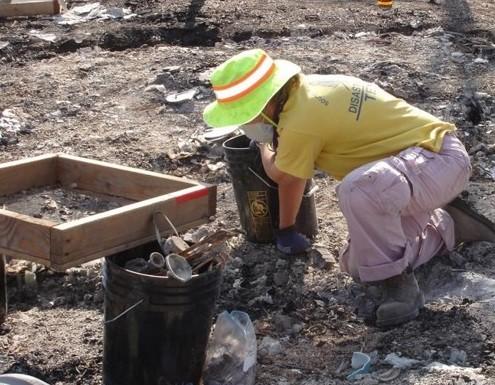
o Shovel several scoops of ash and shake frame until all debris has “sifted: through the screen.
o Search remaining debris for salvageable items.
Clean site
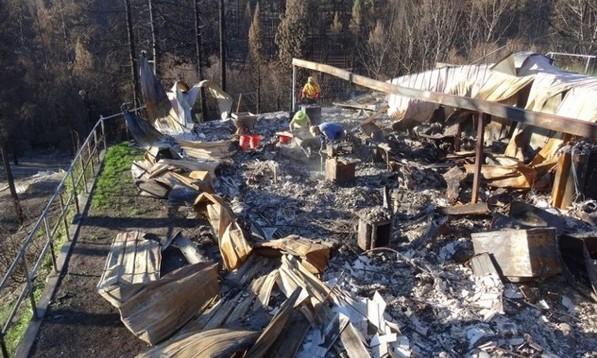
SBDR FIRE RECOVERY MANUAL
o Move all items and debris to the appropriate pile or dumpster.
o Depending on local regulations and amount of ash, the site may need to be sprayed with water to control dust.
Be alert for possible salvageable items throughout the cleanup process.
When in doubt about saving or discarding, ask the homeowner to decide.
Present Bible
Mobile Homes/Trailers
Ashout includes cutting up and removing frames.
Activity may require a chop saw and/or cutting torch.
Heavy Equipment is required to pick up and move the metal.
Section 5: Safety Information
General
In assessing your own situation and making decisions about safety, crews must be the primary concern. Know your limitations. Many well-intentioned volunteers have been injured during operations simply because they did not pay attention to their own physical and mental limitations. You must know your limits and monitor your condition. Fatigue leads to injury.
Work in coordination with others on site
Be aware of where other volunteers are and be concerned for their safety.
Wear gloves and N95 mask
Take regular work breaks. If someone looks overly hot or tired, call for a site break
Take a day off when needed
Sterilize hands before eating or drinking
Be Careful where you step, avoid nails, broken glass, protruding sharp metal corners, exposed wire and other sharp objects.
Maintain hydration
o DRINK LOTS of WATER!
Do not work alone
MAKE SAFETY A PRIORITY!
o Project Safety
o First Aid Kits on all jobs
o Report ALL accidents ASAP (minor or serious) to Crew Leader and Unit Leader.
Safety Equipment
Use appropriate personal protection equipment (PPE).
o Hard hat
o Goggles/Safety glasses
o Appropriate mask (N95) or respirator
o Work gloves
o Long pants (no shorts or cut-offs)
o Shoes/boots
SBDR FIRE RECOVERY MANUAL
Must be solid sole, preferably with a steel or puncture resistant shank and toe.
No Tennis or deck shoes.
Safety Rules
Only trained volunteers are to operate heavy equipment, chainsaws, chop saws, and cutting torches.
Designate a first aid coordinator.
Make safety and hygiene a priority. Get adequate rest, fluids, and nourishment so you can achieve maximum effectiveness.
Personal cleansing
o Take boots and gloves to assigned area to be cleaned. Also, clean equipment (tools, shovels, etc.).
o Keep clean clothes in a plastic bag at housing site.
o Take regular showers and dress in clean clothes.
o Place contaminated clothes in a plastic bag and return clothes to designated location to be laundered in disinfectant.
Lifting should always be done in a way that protects the back from strain or other injury. To lift safely:
o Bend your knees and squat.
o Keep the load close to your body.
o Keep your back straight.
o Push up with your legs.
Don’t be part of the problem, Be part of the solution.
SBDR FIRE RECOVERY MANUAL
